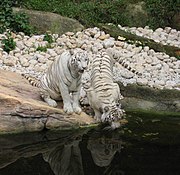White Tiger (Panthera tigris) is a tiger with a genetic condition that nearly eliminates pigment in the normally orange fur although they still have dark stripes. This occurs when a tiger inherits two copies of the recessive gene for the paler coloration: pink nose, grey-mottled skin, ice-blue eyes, and white to cream-coloured fur with black, grey, or chocolate-coloured stripes. (Another genetic condition also makes the stripes of the tiger very pale; white tigers of this type are called snow-white.)
White tigers do not constitute a separate subspecies of their own and can breed with orange ones, although all of the resulting offspring will be heterozygous for the recessive white gene, and their fur will be orange. The only exception would be if the orange parent was itself already a heterozygous tiger, which would give each cub a 50% chance of being either double-recessive white or heterozygous orange.
Compared to orange tigers without the white gene, white tigers tend to be larger both at birth and at full adult size. This may have given them an advantage in the wild despite their unusual coloration. Heterozygous orange tigers also tend to be larger than other orange tigers. Kailash Sankhala, the director of the New Delhi Zoo in the 1960s, suggested that "one of the functions of the white gene may have been to keep a size gene in the population, in case it's ever needed."
Dark-striped white individuals are well-documented in the Bengal Tiger subspecies (Panthera tigris tigris or P. t. bengalensis), may also have occurred in captive Siberian Tigers (Panthera tigris altaica), and may have been reported historically in several other subspecies. White pelage is most closely associated with the
The unusual coloration of white tigers has made them popular in zoos and entertainment that showcases exotic animals. The magicians Siegfried & Roy are famous for having bred and trained white tigers for their performances, referring to them as "royal white tigers" perhaps from the white tiger's association with the Maharaja of Rewa.
It is a myth that white tigers did not thrive in the wild, where small groups had bred white for generations.



